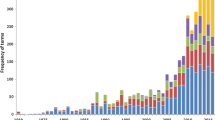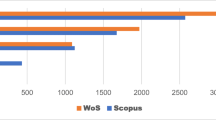Abstract
We have developed a set of routines that allows to draw easily different maps of the research carried out in a scientific institution. Our toolkit uses OpenSource elements to analyze bibliometric data gathered from the Web Of Science. We take the example of our institution, ENS de Lyon, to show how different maps, using co-occurrence (of authors, keywords, institutions…) and bibliographic coupling can be built. These maps may become a valuable tool for discussing institutions’ policies, as they offer different views on the institution at a global scale.






Similar content being viewed by others
References
Agarwal, P., & Skupin, A. (Eds.) (2008). Self-organising maps: Applications in geographic information science. Chichester: Wiley.
Bastian, M., Heymann, S., & Jacomy, M. (2009). Gephi: An open source software for exploring and manipulating networks. Proc 3rd Intl ICWSM Conf.
Blondel, V. D., Guillaume, J.-L., Lambiotte, R., & Lefebvre, E. (2008). Fast unfolding of communities in large networks. Journal of Statistical Mechanics, P10008.
Börner, K. (2010). Atlas of science: visualizing what we know. Cambridge, MA: MIT Press
Börner, K., & Scharnhorst, A. (2009). Visual conceptualizations and models of science. Journal of Informetrics, 3, 161–172.
Börner, K., Chen, Ch., & Boyack, K. (2003). Visualizing knowledge domains. Annual Review of Information Science and Technology, 37, 179–255.
Cambrosio, A., Keating, P., Mercier, S., Lewison, G., & Mogoutov, A. (2006). Mapping the emergence and development of translational cancer research. European Journal of Cancer, 42, 3140–3148.
Chavalarias, D., & Cointet, J.-P. (2009). The reconstruction of science phylogeny, arXiv:0904.3154v3.
Cobo, M. J., López-Herrera, A. G., Herrera-Viedma, E., & Herrera, F. (2011). Science mapping software tools: Review, analysis, and cooperative study among tools. Journal of the American Society for Information Science Technology, 62, 1382–1402.
Fortunato, S., & Barthélemy, M. (2007). Resolution limit in community detection. Proceedings of the National Academy of Science of United States of America, 104, 36–41.
Girvan, M., & Newman, M. E. J. (2004). Finding and evaluating community structure in networks. Phys Rev E, 69, 026113.
Glänzel, W. (2003). Bibliometrics as a research field: A course on theory and application of bibliometric indicators. http://nsdl.niscair.res.in/bitstream/123456789/968/1/Bib_Module_KUL.pd.
Kessler, M. M. (1963). Bibliographic coupling between scientific papers. American Documentation, 24, 123–131.
Klavans, R., & Boyack, K. W. (2009). Toward a consensus map of science. Journal of American Society of Information Science and Technology, 60(3), 455–476.
Leydesdorff, L., & Persson, O. (2010). Mapping the geography of science: Distribution patterns and networks of relations among cities and institutes. Journal of the American Society for Information Science & Technology, 61(8), 1622–1634.
Leydesdorff, L., & Rafols, I. (2009). A global map of science based on the ISI subject categories. Journal of the American Society for Information Science Technology, 60(2), 348–362.
Nietzsche, F. (1969). On the genealogy of morals. New York: Vintage Books (cited by Flyvbjerg B, Making social science matter. Cambridge University Press).
Noyons, E. C. M. (2004). Science maps within a science policy context. In: H. F. Moed, W. Glanzel, & U. Schmoch (Eds.), Handbook of quantitative science and technology research, the use of publication and patent statistics in studies of ST systems (pp. 237–256). Dordrecht: Kluwer Academic publishers.
Rafols, I., & Leydesdorff, L. (2010). Science overlay maps: A new tool for research policy and library management. Journal of the American Society for Information Science Technology, 61(9), 1871–1887.
Roessner, D (2000). Quantitative and qualitative methods and measures in the evaluation of research. Research Evaluation, 9(2), 125–132.
Small, H. (1973). Co-citation in the scientific literature: A new measure of the relationship between two documents. Journal of the American Society for Information Science, 24, 265–269.
Small, H. (1999). Visualizing science by citation mapping. Journal of American Society of Information Science, 50(9), 799–813.
Stirling, A. (2008). “Opening up” and “Closing down”: Power, participation, and pluralism in the social appraisal of technology. Science, Technology and Human Values, 33(2), 262–294.
Wood, D., & Fels, J. (2008). The natures of maps: Cartographic constructions of the natural world. Chicago, IL: University of Chicago Press.
Author information
Authors and Affiliations
Corresponding author
Rights and permissions
About this article
Cite this article
Grauwin, S., Jensen, P. Mapping scientific institutions. Scientometrics 89, 943–954 (2011). https://doi.org/10.1007/s11192-011-0482-y
Received:
Published:
Issue Date:
DOI: https://doi.org/10.1007/s11192-011-0482-y




